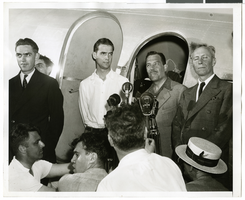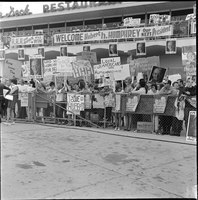Search the Special Collections and Archives Portal
Search Results

Officials present for Boulder City's incorporation ceremony in Boulder City, Nevada: photographic print
Date
1964-03-16
Archival Collection
Description
From the UNLV Libraries Single Item Accession Photograph Collection (PH-00171). L-R: unidentified; Art Olson, Clark County Commissioner; Harold Corbin, U.S. Bureau of Reclamation and Boulder City Manager; Dr. Henry J. Reining, Dean of the College of Administration, USC at Los Angeles; Albert Franklin, Boulder City Councilman; Bob Broadbent, Boulder City Mayor; Dr. Thomas S. White, Boulder City Councilman; Grant Sawyer, Governor of Nevada; William Byrne, Henderson, Nevada mayor; Morgan J. Sweeney, Boulder City Councilman; Arleigh West, Acting Regional Director, Bureau of Reclamation at Boulder City; Joe Manix, Boulder City Councilman; N.E. Broadbent, Mayor of Ely, Nevada; B. Mahlon Brown, Nevada state senator; Harley Harmon, Clark County Commission Chairman; Jake Dieleman, Nevada state assemblyman.
Image

Photograph of Howard Hughes, Ed Lund, and Harry Connor, Houston, Texas July 30, 1938
Date
1938-07-30
Archival Collection
Description
Howard Hughes standing with others in Houston, Texas, during a celebration of his around-the-world event.
Image

Photograph of Howard Hughes and his crew in Floyd Bennett Field, New York, July 10, 1938
Date
1938-07-10
Archival Collection
Description
The black and white view of Howard Hughes and his crew at Floyd Bennett Field in New York. Typed onto a piece of paper attached to the image: "Before Hughes hopped off for Paris. Left to right: Edward Lund, Flight Engineer, Howard Hughes, Grover Whalen, Harry Connor, Navigator and Dick Stoddard Radio Engineer. At Floyd Bennett Airport 7/10/38."
Image

Las Vegas Valley as seen from the City View Trail above Sun City MacDonald Ranch, Henderson, Nevada
Date
2016-09-14
Archival Collection
Description
Images of the Las Vegas Valley as seen from City View Trail above the Sun City MacDonald Ranch neighborhood of Henderson, Nevada.
Image

Las Vegas Valley as seen from the City View Trail above Sun City MacDonald Ranch, Henderson, Nevada
Date
2016-09-14
Archival Collection
Description
Images of the Las Vegas Valley as seen from City View Trail above the Sun City MacDonald Ranch neighborhood of Henderson, Nevada.
Image
Artemus W. Ham Concert Hall, Las Vegas, Nevada, 1976
Level of Description
File
Archival Collection
North Las Vegas Library Photograph Collection on North Las Vegas, Nevada
To request this item in person:
Collection Number: PH-00277
Collection Name: North Las Vegas Library Photograph Collection on North Las Vegas, Nevada
Box/Folder: Folder 26
Collection Name: North Las Vegas Library Photograph Collection on North Las Vegas, Nevada
Box/Folder: Folder 26
Archival Component

Photographs for press release, Hughes demonstrates new radar warning, May 1, 1947
Date
1947-05-01
Archival Collection
Description
Photographs that accompany the attached press release: "HUGHES DEMONSTRATES NEW RADAR WARNING Howard Hughes, at the controls of the TWA Constellation, demonstrates the efficiency of his new radar safety device, which is being installed on all TWA planes and which will be available to all other airlines in the United States as soon as he can produce the equipment. The instrument warns the pilot by a brilliant red light and a warning horn the instant the plane comes too close to the ground, or any building, bridge, mountain, aircraft or other obstacle, regardless of darkness or weather conditions. The device weighs only 16 pounds and costs about $130. (Arrow points to warning lights on instrument panel). Center photo shows the Hughes-piloted Constellation approaching a mountain in Southern California's Santa Monica Range, an area usually voided by pilots because of its dangerous peaks. This particular plane's radar set was equipped with both 500-feet and 2,000-feet warning signals. The 500-feet warning range now being installed on TWA airliners was developed first because the greatest immediate need for it is during approaches and landings. The 2,000-feet warning is designed from enroute flying to guarantee clearance of mountains and other obstacles. Photo at right shows the Constellation veering to the left and climbing at a speed of 300 miles an hour after receiving radar warning of an obstacle in its flight path."
Image

Aerial photograph of Hughes' flying boat docked at harbor, Los Angeles (Calif.), July 16, 1947
Date
1947-07-16
Archival Collection
Description
Howard Hughes' flying boat docked near the waters of Los Angeles Harbor, taken July 16, 1947. "Hughes Aircraft" stamped on the back of the image.
Image


Pagination
Refine my results
Content Type
Creator or Contributor
Subject
Archival Collection
Digital Project
Resource Type
Year
Material Type
Place
Language
Records Classification
